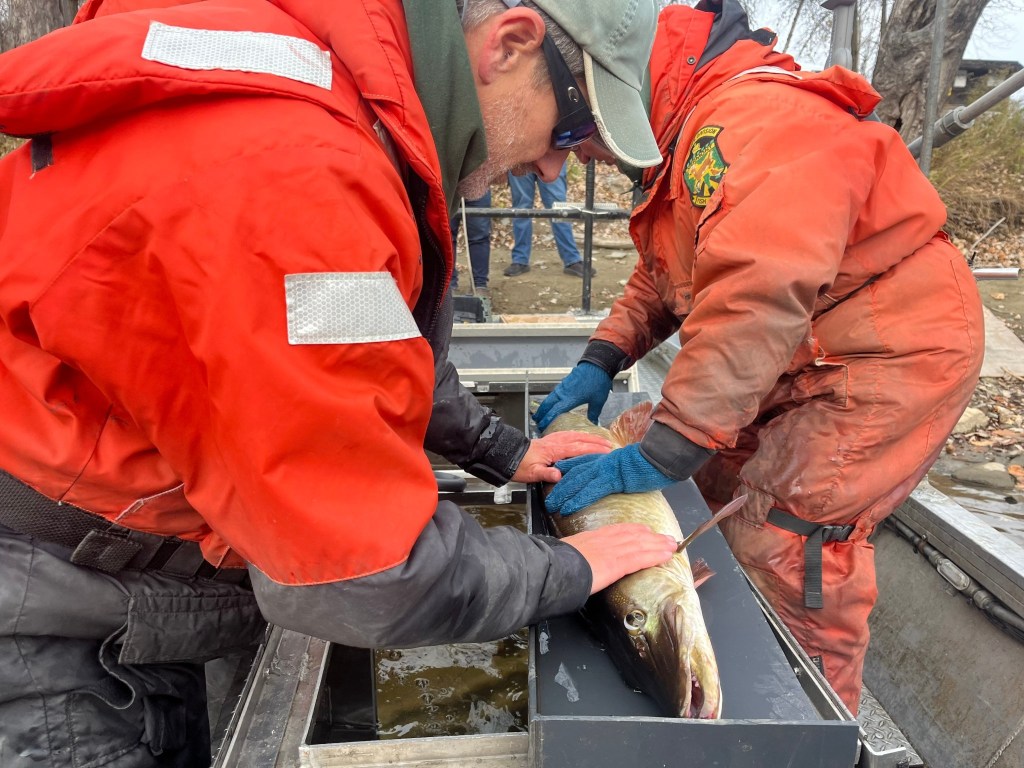

Kate Kampner is a reporter with Community News Service, part of the University of Vermont’s Reporting & Documentary Storytelling program.
Shawn Good has been working to restore muskellunge fish since 2010, when Vermont began stocking them in the Missisquoi Bay and River. But he’s had the idea to bring the species — a once-widespread relative of the pike that can grow to 5 feet long — back to prominence in Lake Champlain for close to 20 years.
Following a reduction in their range to just the Missisquoi River over the 20th century, the muskellunge were seemingly wiped out after an untreated waste spill from a mill in 1979.
Now, after years of releasing fish into the lake, Good and other fisheries biologists have just finished capturing and radio-tagging six adult muskies, as they’re known, to watch their spawning behavior and learn more about how successful the fish have been in reproducing naturally.
“This project is all about bringing them back,” said Good, the Vermont Department of Fish and Wildlife scientist leading the program.
Since 2010, the department has stocked over 66,000 muskies. A portion of them recaptured at age 1 or older are tagged with a microchip that biologists can scan to identify a specific fish. Those tags have allowed Good’s team to monitor muskie growth and survival.
The team finished the final radio tagging only a few weeks ago and is now waiting until the spring for the muskie spawning season to start. Team members tag the fish early to let the muskies have time to recover and get used to their tags, which are inserted into their abdominal cavity. The radio tags last up to six years and allow state workers to find and keep track of where the muskies spawn and lay eggs, Good said.
On the final day of tagging in late October, the scientists were on the Missisquoi River using a slim metal antenna to detect and track the sixth fish in the water.
“We’re just trying to see if the fish are generally in the area right now,” Good said.
The scientists use a metal pole-like tool to send an electrical current into the water and stun the fish so that they can bring them aboard.
“When it comes time to actually start detecting it and their locations for actually spawning and laying their eggs, we’re gonna want to be a lot more specific,” he said.

Each device costs $220, and Good said the team could only fund six for the project so far. But the hope is that those six fish will eventually lead Good and his team to larger populations they can monitor.
When the scientists survey the muskies, they’re looking for how much the fish have grown in length and weight. By using the implanted tags, they can track a fish down and scan it to look at its past numbers. Then scientists can compare those records to the fish’s current length and weight.
“It tells us how much it’s growing in how much time and it gives us good information on how healthy the fish is in terms like is it growing slow, is it growing fast,” Good said.
The team does the same with other fish species, including northern pike, salmon, trout and sturgeon — just some of the many fish that can be found in the Missisquoi.

“With this (electrofishing) boat, we get to see all the fish that a lot of people don’t get to see,” said Dan DeLucia, a seasonal fisheries technician working with Good and his team. “When you start seeing them, it’s great.”
The surveys will allow Good and his team to make a decision on whether they want to stop stocking hatchery fish in the river altogether, he said.
Dave Gibson, a fisheries scientist who has been with Fish and Wildlife for 33 years, said that throughout the process and during his years working, he’s enjoyed seeing how much has changed and how much has improved.
“We’re helping maintain and sustain a population,” he said.

DeLucia said much of the same. “It’s crazy how many we’ve caught this year,” he said. “They’re supposed to be all spread out, so it kind of gives you the assumption that this is a spawning area, that they’re all congregating.”
The goal of the project, Good said, is to restore the muskellunge to a self-sustaining population that naturally reproduces.
“This is a restoration project. We’re trying to restore these fish species to Vermont,” Good said. “It’s a career of work you’re seeing.”
At the heart of it all, DeLucia said, “We’re just trying to get people to care about them like we care about them.”
Correction: The six muskies in question were being radio-tagged for the first time, not re-tagged, and only fish age 1 or older are fitted with transponders. Fish and Wildlife is only tagging and tracking mature muskies. The chemical spill that seemingly eliminated the remaining original muskie population occurred in 1979.
Read the story on VTDigger here: Radio tags let scientists monitor muskies in the Missisquoi.

